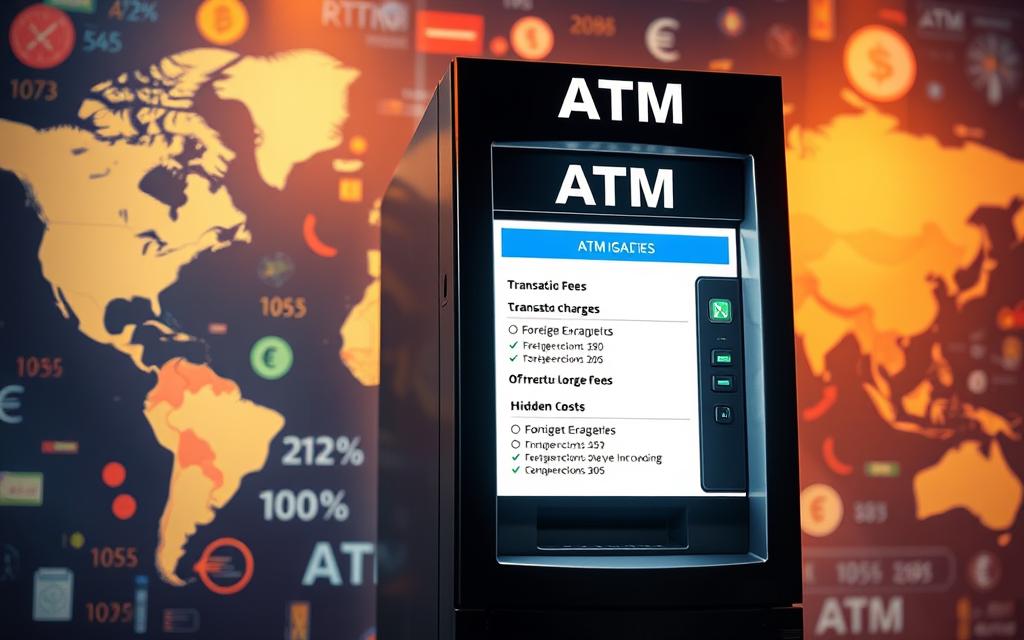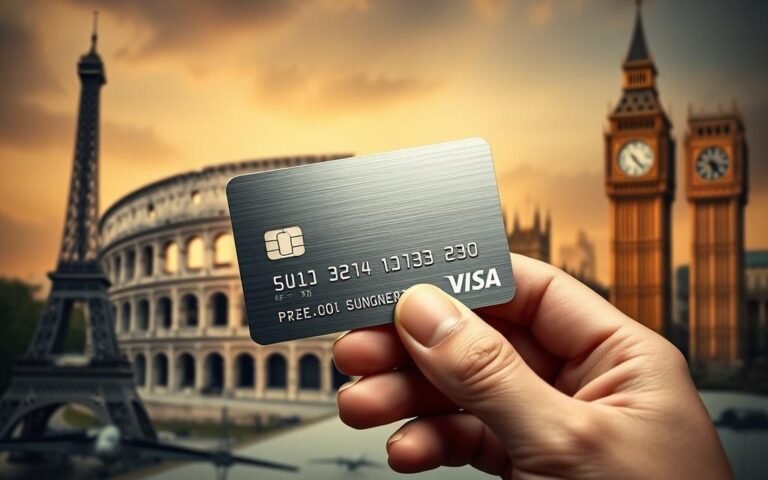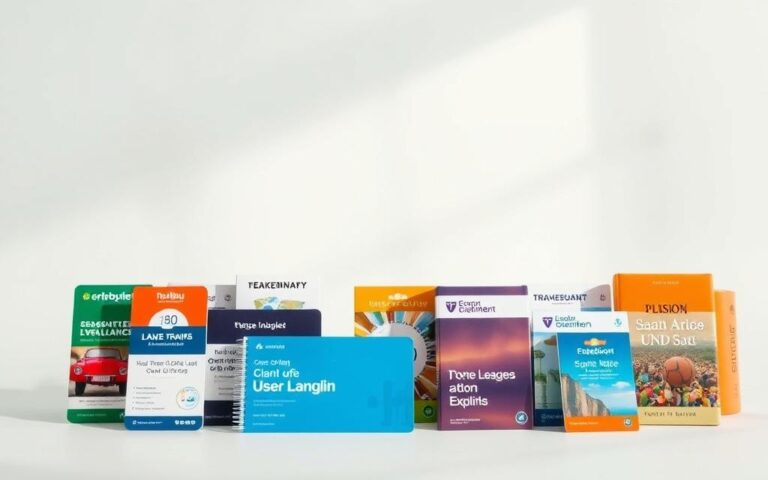Advertisement
Did you know using an ATM abroad can add fees from 1% to 20% of your withdrawal? These hidden ATM fees can quickly reduce your travel budget. It’s key for anyone traveling internationally to understand these charges. Not doing so can lead to unnecessary expenses.
When getting cash from ATMs overseas, knowing about international ATM charges is vital. Being prepared helps you dodge these fees, allowing affordable and easy access to your money while exploring. We’ll explore more about ATM fees and tips to avoid them during international trips.
Understanding ATM Fees When Traveling Internationally
Going abroad can be full of adventure, but watch out for hidden costs. Many forget to check the fees for using ATMs in other countries. Knowing these expenses can save you from surprise costs during your journey.
Common Types of ATM Fees
When you take out cash from foreign ATMs, you’ll likely face some fees. Here are the main ones:
- ATM transaction fees: Charged by the machine’s owner for each withdrawal.
- Foreign transaction fees: Your bank may charge these for withdrawals outside your home country.
- Currency conversion charges: These are for changing your money into the local currency.
How Fees Vary by Country
ATM fees can change a lot depending on the country. Some places have low fees, while others are quite high. For example, fees in Europe might be lower than in remote areas. Make sure to look up fees in the country you’re visiting.
Currency Conversion Rates
The rates for changing your money can greatly affect your withdrawal costs. Different ATMs might give you different rates. Always double-check the exchange rate at the ATM. This way, you can avoid bad rates that raise your total withdrawal cost.

The Importance of Research Before You Travel
Knowing about ATM fees before going abroad saves you money. It’s key to learn how your bank handles international ATM use. This way, you avoid unexpected fees when withdrawing money over there.
Different banks have different rules. Understanding these can prevent surprises with charges.
Investigating Your Bank’s Policies
Before you set off, look into your bank’s rules on international ATM use. Some banks offer deals that reduce fees, others don’t. Knowing your bank’s foreign ATM policies tells you if they have no fees or high ones.
Identifying Local ATM Fee Structures
It’s also smart to know about ATM fees in the place you’re visiting. Find out what you’ll typically pay there. Websites and travel forums can help you learn about local ATM fees.

Choosing the Right Bank for International Withdrawals
When traveling, choosing the right bank is crucial. It helps in lowering costs during overseas trips. We’ll look at banks with global partnerships and fee-free ATM access abroad.
Banks with Global Partnerships
Banks with worldwide partners offer better international services. Customers can use ATMs of partner banks with low or no fees. For example, Chase, Citibank, and Bank of America have strong global networks.
Fee-Free Withdrawals Abroad
Choosing a bank that doesn’t charge for ATM use abroad is smart. Banks like Charles Schwab and Fidelity cover all ATM fees and refund third-party charges. This makes them top choices for international travel. Always review a bank’s policies to ensure you get the best deal.
Tips for Minimizing Fees at ATMs
Traveling abroad often brings unexpected costs, especially with cash withdrawals. To cut ATM fees, plan ahead and know the local ways. By using clever strategies, you can save a lot.
Opting for Local Currency Withdrawals
Always withdraw in the local currency when abroad. Avoiding dynamic currency conversion saves money as it comes with higher fees. Getting money in local currency lowers costs and gives better value.
Keeping an Eye on Exchange Rates
Watching exchange rates is key to spending less on trips. Use trusted apps or websites to keep track as rates can change a lot. Take money out when rates are good to get more for your money.
Try to make fewer, bigger withdrawals. This way, you pay ATM fees less often, saving money.
The Role of Credit Unions and Online Banks
Banking choices can greatly affect your ability to get money while traveling. Credit unions are great for using ATMs because they have lower fees and offer personal service. They focus on local communities, which can mean lower costs. Online banks are good too, especially if you don’t want to pay a lot of fees to access your money.
Benefits of Using Community Banks
Community banks put a lot of emphasis on customer service and being involved locally. They can often charge less than big banks. This can make banking better for you, especially when taking money out in other countries. They also help local economies by investing in nearby projects.
Features of Online Banks to Consider
Online banks that don’t charge a lot of fees are great for people who like technology, offering lots of handy features. When looking at online banks, consider these important aspects:
- User-friendly interfaces for keeping an eye on transactions abroad.
- Low or no fees for international withdrawals, making getting cash easier.
- Robust security measures to keep your information safe.
- 24/7 customer support, always there to help during your travels.
Online banking can make handling your finances while abroad simpler, safer, and more convenient.
Understanding Dynamic Currency Conversion
Dynamic Currency Conversion (DCC) lets travelers pay in their home currency abroad. It’s popular but knowing how DCC works and its effects is key. You’ll find this option at ATMs and with many merchants.
What is Dynamic Currency Conversion?
DCC is a currency exchange service by payment processors. You can pick to view prices in your home currency using current rates. It provides clear cost understanding in dollars. But, DCC fees can reduce the savings.
Pros and Cons of Using DCC
DCC has good and bad points for travelers. A big plus is knowing the exact amount in your home currency. It also makes transactions abroad simpler, no need for more math.
- Advantages:
- Clear understanding of charges.
- Easier math while traveling.
- Disadvantages:
- High fees due to bad exchange rates.
- Missing out on local currency savings.
It’s important to watch out for DCC fees. Knowing about DCC can help with smarter spending abroad.
How to Use ATMs Safely All Over the World
Traveling makes using ATMs super handy. But, staying safe is key. Knowing which ATMs are safe and how to keep your info secure makes a big difference. So, here are tips to keep your transactions safe.
Signs of a Legitimate ATM
To pick a safe ATM abroad, look for these clues:
- Branding: Look for well-known bank logos.
- Location: Choose ATMs in bright places close to banks or reliable shops.
- Functionality: The machine should look in good condition without odd parts or damage.
- Security Features: Good ATMs often have a camera or other safety steps.
By spotting these signs, you can steer clear of scams like card skimmers.
Protecting Your Information
It’s crucial to guard your personal info at ATMs. Here’s how:
- Privacy: Hide your PIN from people around you.
- Withdrawal Limits: Having a withdrawal limit can lessen loss from theft.
- Transaction Monitoring: Always check your statements for weird charges.
- Inform Your Bank: Tell your bank when you’re traveling to avoid account freezes.
With these safety tips, your ATM use while traveling will be more secure. Enjoy worry-free banking on your trips!
What to Do If You Encounter Unexpected Fees
Running into unexpected ATM fees is annoying, more so when abroad. To tackle these fees, knowing what steps to take is key. First, get in touch with your bank for help. Banks have teams ready to handle ATM issues, helping you understand any weird charges.
Contacting Your Bank for Assistance
If you see a strange fee, call your bank right away. Be sure to have your transaction info handy, which speeds things up. Banks offer special support for travel issues, ensuring quick and right answers. Getting help quickly can sort out ATM fee problems and let you know your rights.
Disputing Unauthorized Charges
Facing charges you didn’t approve? Act fast. Keep records of the transaction and any talks with the ATM provider or bank. This documentation is crucial for fighting unwelcome charges. Banks will help you dispute these fees, so you can get your money back and stay in charge of your finances while on the go.



